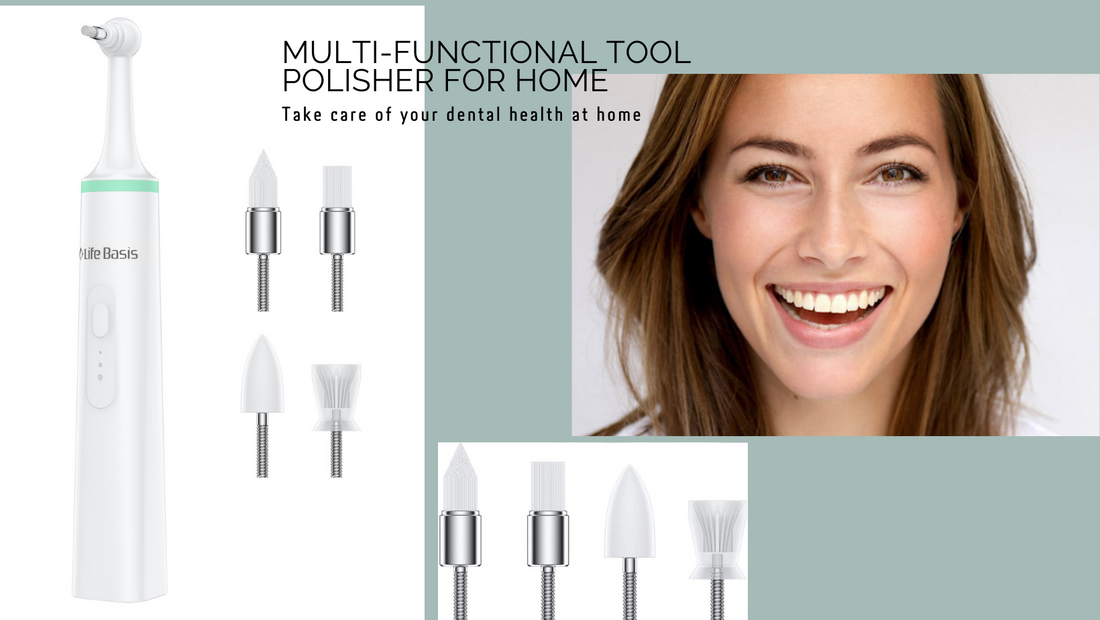Dental polisher, also named tooth polisher, it is used to keep your teeth healthy. What can tooth polisher do? Can you polish your teeth at home? is teeth polishing necessary? if you want to keep your teeth clean and white, have special needs such as those with braces, missing teeth, sensitive gums, etc. i think ,yes!
What Is Teeth Polishing And What Can Teeth Polisher Do?
At your regular appointment, your hygienist will first clean your teeth and remove any plaque buildup. This process is called scaling. After your teeth are clean, your hygienist might take scans of them. Then, your dentist will inspect your teeth for any cavities and other problems. Lastly, they'll polish your teeth to get rid of any lasting plaque.
A tooth polisher can smooth the surface of your teeth, remove stains, get rid of plaque,make your teeth look shiny and clean,prevent gum disease and irritation etc.Polishing can get rid of stains from:Coffee, Wine, Tea, Smoking, Betel quid or areca nut chewing.
Is Teeth Polishing Necessary?
As we all know that, teeth polishing can make teeth smooth and gleam. But imporper operation may damage your enamel and cause tooth sensitivity or hurt your gums.
Tooth polishing helps keep plaque off your teeth. Research suggests that teeth polishing doesn’t stop you from getting gum disease, but people who have polishing done tend to have less bacteria.
It used to be standard for all teeth to be polished until research showed that doing so removed enamel. Then in the 1970s, an influential textbook, “Clinical Practice of the Dental Hygienist,” by Dr. Esther Wilkins, recommended “selective polishing” – meaning the hygienist should only shine stained parts of the teeth and not the whole set.
As to whether enamel will be worn down, Dr. Frantsve-Hawley, a registered dental hygienist who has a Ph.D. in biological and biomedical sciences, said twice-a-year polishing at the dentist’s office, even with the coarsest paste, is “not frequent enough to cause significant damage to the enamel.”
Dr. Lorentzen agreed, saying, “Polishing is not a significant risk.” By contrast, not utilizing a soft toothbrush or brushing too hard daily can damage the gentler structures of the teeth, like the cementum, the surface layer of the tooth root.
“Polishing is both cosmetic and healthy. While it certainly can significantly improve the look of your teeth, it also removes unwanted plaque and biofilm, to create healthy gums.”
— Dr. Linhart, Linhart Dentistry, New York
Tooth Polishing Types
Rubber cup.
Your dental hygienist uses a slow drill with a rubber cup or brush. The cup is dipped in some dental polishing paste and then applied to your teeth. The paste is an abrasive that scrubs away any stains and plaque.
Air powder polishing.
With this, they'll use a slurry of water and baking soda with air and water pressure to polish your teeth. It’s sometimes used with an ultrasonic plaque remover.
Air polishing is used in between teeth and cracks where the rubber cup can’t reach and to remove plaque above your gum line.
Prophylactic Paste (Polishing Paste)
Prophylactic paste contains abrasives that vary in size, shape, and hardness.[5] Based on these variants, pastes are available in fine, medium, coarse and super-coarse grits.[1] There are also various flavours of prophylactic paste available. Some prophylactic pastes contain fluoride to aid in the remineralization of the enamel surface and others help reduce dentinal sensitivity.
Bristle brush
Bristle brushes are used in the prophylaxis angle with a polishing paste. The use of the brush should be confined to the crown to avoid injury to the gingiva and cementum.
Prophy angle
Currently, the most commonly used tool for tooth polishing is prophy angle. It integrates a rubber cup into a high torque gear, which can be plugged into a low speed handpiece and drive rubber cup to polish teeth.
Dental tape
Dental tape is used for polishing the proximal surfaces of teeth that are inaccessible to other polishing instruments. It is also used with polishing paste. Particular care should be taken to avoid injury to the gingiva. The area should be cleaned with warm water to remove all remnants of the paste.
When You Need To Do Teeth Polishing?
Current evidence suggest that prophylactic polishing is only necessary when extrinsic stain is present on the tooth surface. This suggests that tooth polishing should be based on individual needs. If your teeth bother you, or if you’re thinking about trying a dental polishing home kit, make sure to talk to your dentist.
Oral Care Tips
- Brush your teeth with fluoride toothpaste every morning and before bed
- Floss your teeth twice daily
- Eat a healthy diet with lots of fruits and vegetables
- Drink less sugary drinks
- Eat less sugary treats
- Treat your teeth problems as soon as possible
Enjoy!
LifeBasis share items with you for dalily routine!
Website: www.lifebasis.com
Contact: webmaster.com
Facebook: https://www.facebook.com/LifeBasis-114571757912143
Instargram: https://www.instagram.com/life_basis/
Youtube:https://www.youtube.com/channel/UCdpfzrpDa88XZKb22LtTLBg





1 comment
I have this and need the replacement attachments, do you have them?